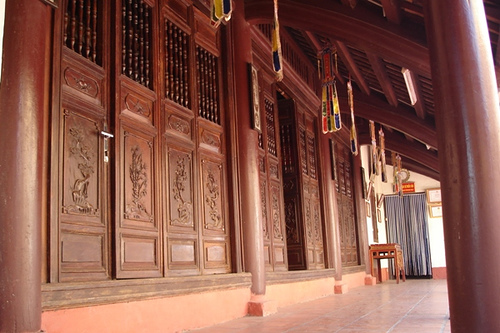 |
| HO CHI MINH |
Chua Viet, or Vietnamese Buddhist Temples, are similar to, and yet distinct from, their Chinese equivalents. The Vietnamese pagoda is usually a single-storeyed structure rather than a multi-tiered tower. Most will have a sacred pond-usually replete with sacred turtles-a bell tower, and a garden.
Showing posts with label Hanoi pagoda. Show all posts
Showing posts with label Hanoi pagoda. Show all posts
Sunday, 30 December 2012
Ho chi minh mausoleum complex
HO CHI MINH'S MAUSOLEUM in the tradition of Lenin and Stalin before him-and Mao afterwards is a monumental marble edifice.Contrary to his desire for a simple cremation ,the mausoleum was con-structed from materials gathered from all over Vietnam between 1973 and 1975.The roof and perestyle are said to evoke either a traditional communal house or a lotus flower,though to many tourist it looks like a concret cubicle with columns.Set deep in the bowels of the building in a plass sarcophagus is the frail,pale body of HO CHI MINH.The mausoleum is closed of about,two months each year while HO CHO MINH'S embalmed corpse goes to Russia for maintenance.
The queue,which moves quite quickly,usually snakes for several hundred metres to the mausoleum entrance itself.Inside,adopt a slow but steady walking pace as you file past HO's body.Guards,regaled in snowny while military uniforms,are posted at intervals of five paces,giving an eerily authoritarian aspect to the slightly macabre while hair.
The following rules are strictly applied to all visitor to the mausoleum:
People wearing shorts,tank tops and so on will not be admitted.
Nothing (including day packs,cameras and mobiles) can be taken inside.
maintain a respectful demeanour at all times:no talking or sniggering.
it isforbiddend to mut your hands in your pockets.
hats must be taken off inside the mausoleum building.
Tags:
Hanoi pagoda
Google Account Video Purchases
Ho Chi Minh Mausoleum, Điện Biên, Ba Dinh District, Hanoi, Vietnam
Tran Quoc pagoda in Hanoi
 |
| Tran Quoc pagoda |
History
 Tran Quoc Pagoda was first erected with the name “Khai Quoc” (Opening a country) during King Ly Nam De Dynasty, between year 544 and 548 on the bark of Red River (approximately within Yen Phu Ward, Tay Ho District now). Till the 15th century, during King Le Thai Tong reign, it was renamed to “An Quoc”, which means a peaceful country.
Tran Quoc Pagoda was first erected with the name “Khai Quoc” (Opening a country) during King Ly Nam De Dynasty, between year 544 and 548 on the bark of Red River (approximately within Yen Phu Ward, Tay Ho District now). Till the 15th century, during King Le Thai Tong reign, it was renamed to “An Quoc”, which means a peaceful country.In 1915, due to a serious landslide ingrained into the pagoda’s foundation that made the incumbent government and people to move the whole construction to Kim Ngư Island on the East of West Lake, and this is Tran Quoc Pagoda’s current location that you can witness in this day and age. The renaming process didn’t stop until it was changed to the name “Tran Quoc Pagoda”, meaning protecting the country, during King Le Huy Tong dynasty (1681-1705). Through each name of the pagoda, we can see a milestone of the country as well as the wishes of its people attached to this holy sanctuary.
Landscape and architecture
Besides the front gate facing the crowded Thanh Nien Road, this 3,000m2 complex is surrounded by sliver tide of West Lake, and is designed according to strict rules of Buddhist architecture with many layers of buildings and three main houses called “Tiền Đường”, a house for burning incense and "thượng điện". These rooms are connected with each other to form a Công script .
The precinct of Tran Quoc Pagoda is highlighted by a high stupa that you may recognize from a far erected in 1998. This stupa is composed of 11 floors with a height of 15m; each floor has a vaulted window holding a statue of Amitabha made from gemstone. On the top stands a nine-storey lotus (Cửu đỉnh liên hoa) and is also gemstone. This stupa is situated symmetrically with the 50-year-old Bodhi tree gifted by former Indian President on the occasion of his visit to Hanoi in 1959. Abbot Thich Thanh Nha of Tran Quoc Pagoda explains the meaning of this correlation: “The lotus represent Buddha while the Bodhi is a symbol of supreme knowledge”.
Not only that, Tran Quoc is also a small museum of priceless antiques dated thousands to hundreds years old like worshiping statues in the front house. These statues are all engraved and polished meticulously by skillful craftsmen, which all bear spectacular features. Among them, the outstanding one is the statue “Thích ca thập niết bàn”, which is evaluated as the most beautiful statue of Vietnam.
With all the historical and architectural values it possesses, Tran Quoc Pagoda is not only worth visiting as a sacred sanctuary of Buddhism attracting countless Buddhist believers; but also an indispensible destination for cultural explorers to Vietnam.
Tags:
Hanoi pagoda
Google Account Video Purchases
Chùa Trấn Quốc, Yên Phụ, Tay Ho district, Hanoi, Vietnam
Subscribe to:
Comments (Atom)



